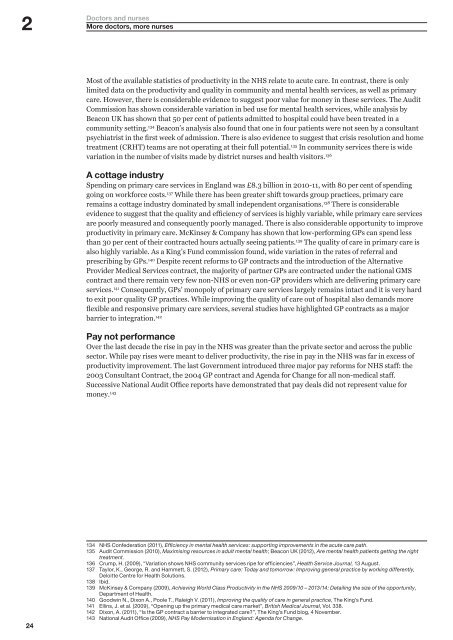Doctors and nurses - Reform
Doctors and nurses - Reform
Doctors and nurses - Reform
Create successful ePaper yourself
Turn your PDF publications into a flip-book with our unique Google optimized e-Paper software.
2<br />
<strong>Doctors</strong> <strong>and</strong> <strong>nurses</strong><br />
More doctors, more <strong>nurses</strong><br />
Most of the available statistics of productivity in the NHS relate to acute care. In contrast, there is only<br />
limited data on the productivity <strong>and</strong> quality in community <strong>and</strong> mental health services, as well as primary<br />
care. However, there is considerable evidence to suggest poor value for money in these services. The Audit<br />
Commission has shown considerable variation in bed use for mental health services, while analysis by<br />
Beacon UK has shown that 50 per cent of patients admitted to hospital could have been treated in a<br />
community setting. 134 Beacon’s analysis also found that one in four patients were not seen by a consultant<br />
psychiatrist in the first week of admission. There is also evidence to suggest that crisis resolution <strong>and</strong> home<br />
treatment (CRHT) teams are not operating at their full potential. 135 In community services there is wide<br />
variation in the number of visits made by district <strong>nurses</strong> <strong>and</strong> health visitors. 136<br />
A cottage industry<br />
Spending on primary care services in Engl<strong>and</strong> was £8.3 billion in 2010-11, with 80 per cent of spending<br />
going on workforce costs. 137 While there has been greater shift towards group practices, primary care<br />
remains a cottage industry dominated by small independent organisations. 138 There is considerable<br />
evidence to suggest that the quality <strong>and</strong> efficiency of services is highly variable, while primary care services<br />
are poorly measured <strong>and</strong> consequently poorly managed. There is also considerable opportunity to improve<br />
productivity in primary care. McKinsey & Company has shown that low-performing GPs can spend less<br />
than 30 per cent of their contracted hours actually seeing patients. 139 The quality of care in primary care is<br />
also highly variable. As a King’s Fund commission found, wide variation in the rates of referral <strong>and</strong><br />
prescribing by GPs. 140 Despite recent reforms to GP contracts <strong>and</strong> the introduction of the Alternative<br />
Provider Medical Services contract, the majority of partner GPs are contracted under the national GMS<br />
contract <strong>and</strong> there remain very few non-NHS or even non-GP providers which are delivering primary care<br />
services. 141 Consequently, GPs’ monopoly of primary care services largely remains intact <strong>and</strong> it is very hard<br />
to exit poor quality GP practices. While improving the quality of care out of hospital also dem<strong>and</strong>s more<br />
flexible <strong>and</strong> responsive primary care services, several studies have highlighted GP contracts as a major<br />
barrier to integration. 142<br />
Pay not performance<br />
Over the last decade the rise in pay in the NHS was greater than the private sector <strong>and</strong> across the public<br />
sector. While pay rises were meant to deliver productivity, the rise in pay in the NHS was far in excess of<br />
productivity improvement. The last Government introduced three major pay reforms for NHS staff: the<br />
2003 Consultant Contract, the 2004 GP contract <strong>and</strong> Agenda for Change for all non-medical staff.<br />
Successive National Audit Office reports have demonstrated that pay deals did not represent value for<br />
money. 143<br />
24<br />
134 NHS Confederation (2011), Efficiency in mental health services: supporting improvements in the acute care path.<br />
135 Audit Commission (2010), Maximising resources in adult mental health; Beacon UK (2012), Are mental health patients getting the right<br />
treatment.<br />
136 Crump, H. (2009), “Variation shows NHS community services ripe for efficiencies”, Health Service Journal, 13 August.<br />
137 Taylor, K., George, R. <strong>and</strong> Hammett, S. (2012), Primary care: Today <strong>and</strong> tomorrow: Improving general practice by working differently,<br />
Deloitte Centre for Health Solutions.<br />
138 Ibid.<br />
139 McKinsey & Company (2009), Achieving World Class Productivity in the NHS 2009/10 – 2013/14: Detailing the size of the opportunity,<br />
Department of Health.<br />
140 Goodwin N., Dixon A., Poole T., Raleigh V. (2011), Improving the quality of care in general practice, The King’s Fund.<br />
141 Ellins, J. et al. (2009), “Opening up the primary medical care market”, British Medical Journal, Vol. 338.<br />
142 Dixon, A. (2011), “Is the GP contract a barrier to integrated care?”, The King’s Fund blog, 4 November.<br />
143 National Audit Office (2009), NHS Pay Modernisation in Engl<strong>and</strong>: Agenda for Change.

















